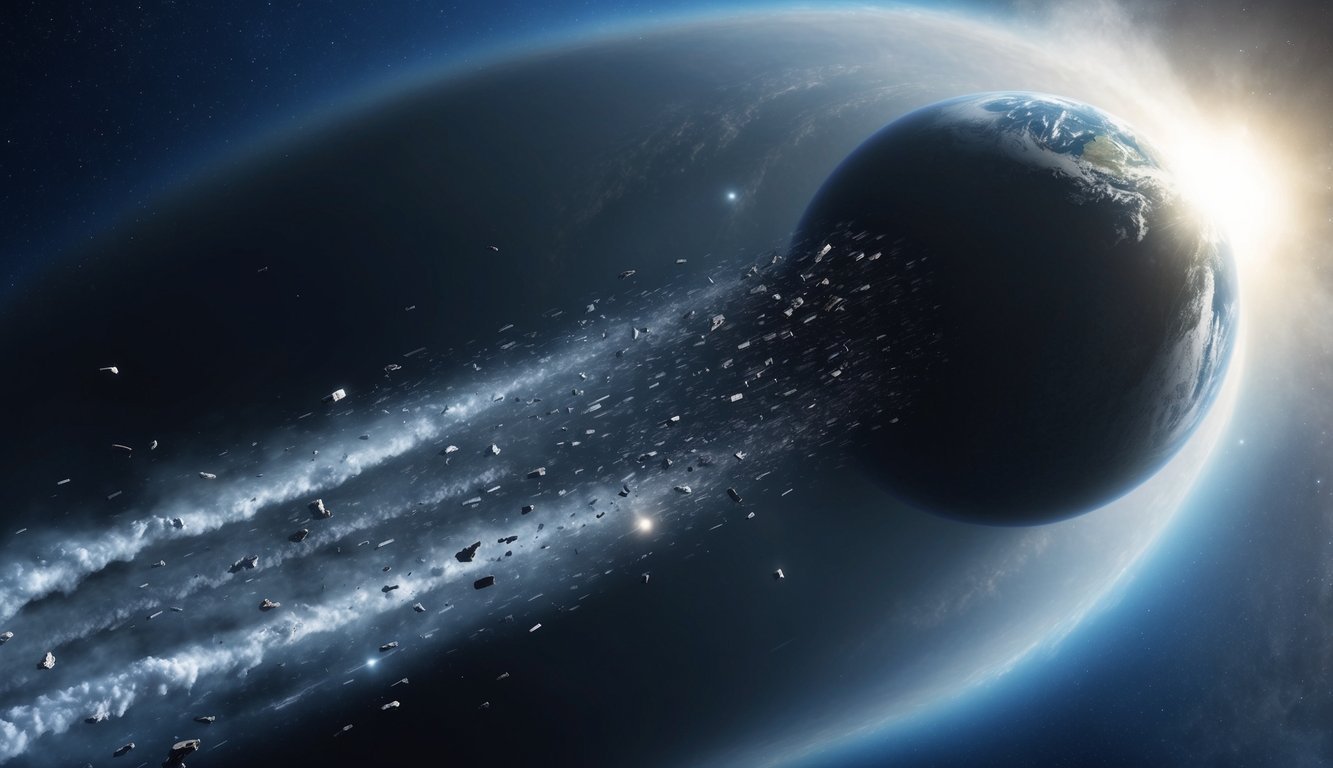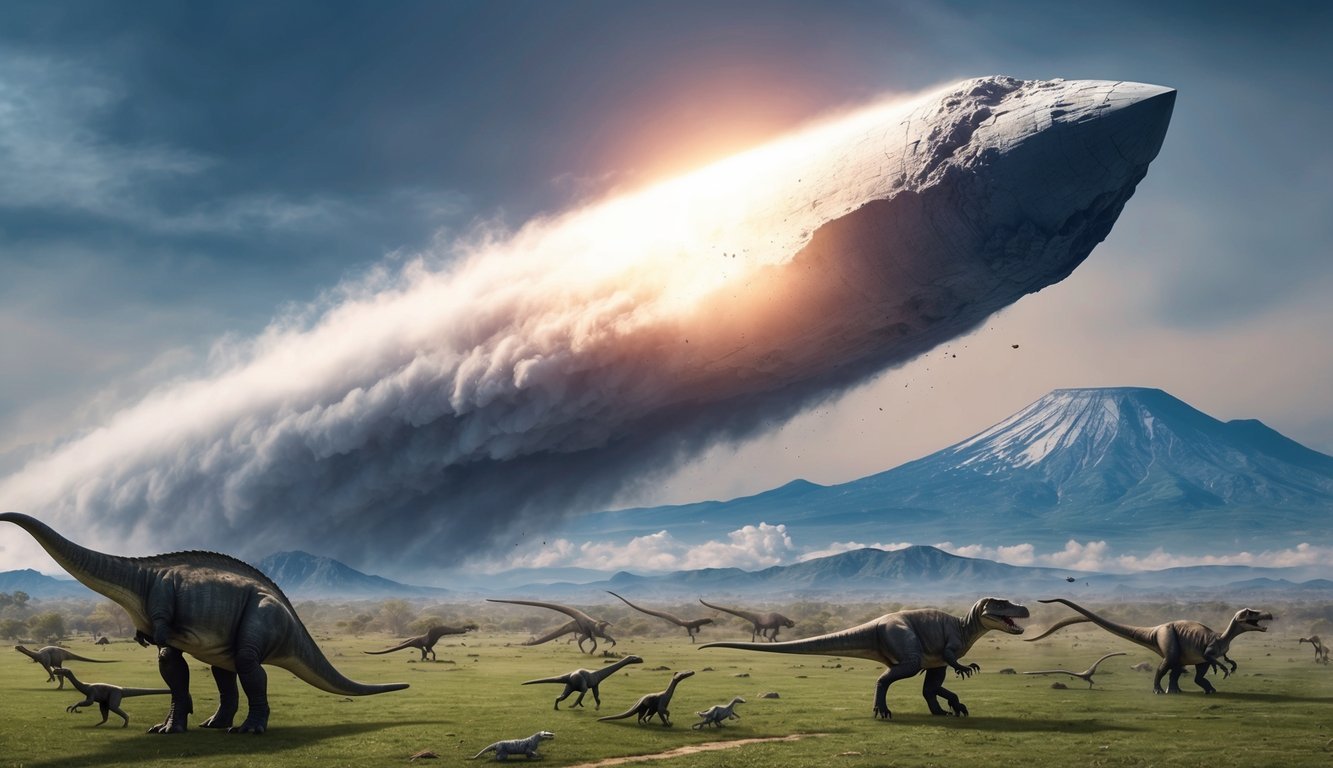Physical Address
304 North Cardinal St.
Dorchester Center, MA 02124
Physical Address
304 North Cardinal St.
Dorchester Center, MA 02124
The Chicxulub impactor, possibly a comet from the Oort Cloud, struck Earth 66 million years ago, leading to mass extinction and altering life on the planet.

I find the story behind the Chicxulub impactor fascinating.
This space rock is thought to have played a huge role in what wiped out the dinosaurs.
It’s amazing to think about what it might’ve looked like soaring through space.
Some scientists, like Amir Siraj and Avi Loeb, suggest that the Chicxulub impactor might be a comet from the Oort Cloud.
The Oort Cloud is this mysterious area filled with icy bodies way out in our solar system.
It’s like the edge of the galaxy!
They propose that this comet was a carbonaceous chondrite.
Now, what’s that, you might ask? It’s a type of asteroid that has organic compounds and water.
I wonder if that means it carried some life-giving ingredients to Earth.
There’s ongoing debate about whether it was an asteroid or a comet that caused the big bang at Chicxulub.
The differences matter because they can shape what we know about Earth’s history.
It really makes me think about how much we still don’t know and how new theories can shift perspectives.
Honestly, each discovery brings us a step closer to understanding our planet’s past.
It’s like piecing together a jigsaw puzzle where every piece is crucial in revealing the full picture of what happened millions of years ago.

The disappearance of dinosaurs is a captivating topic that makes me curious.
There are many theories surrounding their sudden end, particularly during the Cretaceous Period.
One major event, the Chicxulub impact, played a significant role and led to some devastating changes on Earth.
The Cretaceous Period was the final stretch for the dinosaurs, lasting from about 145 million to 66 million years ago.
I find it amazing how diverse the dinosaurs were during this time.
They ruled the land, sea, and sky.
Then, out of nowhere, the asteroid hit the Yucatán Peninsula.
Talk about a game changer! This impact created the Chicxulub crater, causing massive fires and throwing debris into the atmosphere.
I wonder how different things might have been if that hadn’t happened.
This led to a dark period, known as “impact winter,” where sunlight barely reached the ground.
Crops couldn’t grow, and many dinosaurs starved.
It’s mind-boggling to think that a single event could bring about such a sudden end.
The aftermath of the impact was brutal.
With food chains collapsing, dinosaurs struggled to survive.
Some might’ve made it for a while, but it was tough.
The once vibrant ecosystems turned into wastelands, and I can’t help but feel a sense of loss thinking about it.
Many species faced extinction, not just the dinosaurs.
The climate changed dramatically, and life was forever altered.
I think about how even the smallest creatures played roles in that system, and suddenly they, too, faced extinction.

When I think about comets and asteroids, it’s kind of like comparing apples and oranges.
They both float around in space, but they’re not the same.
Asteroids are typically rocky and metallic.
Most of them hang out in the Main Belt, which is between Mars and Jupiter.
They can come in all sizes, some even big enough to cause a big splash if they hit Earth.
On the other hand, we have comets.
These guys are like the fluffy clouds of the solar system.
They’re made of ice, dust, and rocky materials.
When they get close to the sun, they heat up and start to release gas and dust.
This creates that beautiful, glowing tail we often see.
Then there are long-period comets.
They take a long time to complete their orbits, sometimes thousands of years.
It blows my mind to think about how patient they must be, just waiting for their turn to swing by the sun.
And don’t forget about sungrazers! These are comets that come really close to the sun.
They can sometimes break apart because of the intense heat.
So, whether it’s a rock or a icy ball drifting through space, both comets and asteroids remind us of the wonders of our universe.
Honestly, it makes me think about how small we are in the grand scheme of things.

Exploring our solar system feels like embarking on a thrilling adventure.
I can’t help but be amazed by the vastness of space.
Two key areas, the Oort Cloud and the influence of Jupiter, really stand out when I think about the comets traveling through our cosmic neighborhood.
The Oort Cloud is fascinating.
Picture a distant, icy shell surrounding our solar system.
It’s way out there, possibly a light year away! It acts like a reservoir of comets.
I’ve read that many comets, including the ones that might have crossed paths with Earth, likely come from this mysterious region.
I often wonder what’s out there, floating in that cloud.
Each comet carries bits of history from when our solar system formed.
The Oort Cloud isn’t easy to see.
It’s so far away that we can only guess its size and shape.
Still, scientists think it might contain trillions of icy bodies.
Imagine that—trillions of potential visitors to our planet!
Jupiter, our solar system’s giant, plays a huge role in shaping the trajectories of comets and asteroids.
Its massive gravitational field can attract or deflect these objects.
Sometimes, a comet gets pulled closer to the sun, and that path can lead it toward Earth.
I find it wild to consider how Jupiter’s presence can actually protect us by pushing dangerous objects away.
The tidal forces it creates can change orbits, sending some objects spinning into the inner solar system.
Others may just get flung away.
The dance between Jupiter and these icy bodies reminds me of a cosmic game of tag.
We often don’t realize how interconnected everything is in space.
The journey of a comet can be a long one, but thanks to Jupiter, it may just avoid our planet.
That’s a relief!

Modern science is like a treasure map, guiding us to understand the origins of Chicxulub.
With advanced tools and creative thinking, we’re piecing together the puzzle of the comet that might’ve changed Earth’s history forever.
I find it fascinating how scientists use gravitational simulations to replicate cosmic events.
These simulations help us visualize what could’ve happened when that massive object hit Earth millions of years ago.
They examine how the impact altered the planet’s environment, possibly leading to mass extinctions.
In labs, researchers at places like Harvard University run tests that mimic the effects of a tidal disruption event.
It’s mind-blowing to consider how a comet or asteroid whirling through space can be modeled on a computer.
We’re learning how similar impacts might threaten us today and how our own planet has been shaped by these historical events.
The Vera Rubin Observatory is a game-changer in space science.
It’s designed to monitor the asteroid population and look out for potentially dangerous objects.
By capturing images of the night sky, this observatory helps track moving objects and their paths.
It combines big data analysis with astronomy to better predict future impacts.
The more we know about these cosmic players, the clearer the picture becomes of their potential threats.
Honestly, it makes me think about how we can protect Earth from the unknown dangers zipping through our solar system.

Sometimes, I find myself pondering the mysteries around the Chicxulub crater and the asteroid that led to the dinosaurs’ fate.
Let’s dive into some questions that many of us have about this incredible topic.
The asteroid was a whopper! It’s estimated to have been about 6 miles wide when it hit.
Just imagine something that massive coming at Earth! That size is part of what caused all the chaos, like climate changes and disasters that wiped out so many species.
Today, the Chicxulub crater is mostly buried under layers of rock and sediment.
It’s located near the Yucatán Peninsula in Mexico.
There are parts that we can see, but a lot of it is hidden under the earth.
It’s fascinating how nature takes its course and covers even such a huge impact event!
Oh, we can actually see real photos! Satellite images and geological surveys give us a peek at the crater’s outline.
While some artwork helps us visualize things during the impact, there are concrete images that show the crater’s ring and features.
They really help in making this epic event feel more real.
Honestly, there’s still some debate.
Many scientists agree that the asteroid impact was a major factor in the extinction event.
But there are other ideas too, like volcanic activity and climate changes.
It’s like a puzzle that’s not entirely put together yet!
The space rock that created the Chicxulub crater is deep in the Earth now, mixed with layers of rock and debris.
Scientists have drilled into the crater and found bits of the impact material.
Isn’t it cool that we’re still uncovering pieces of history, even after all these years?
That asteroid was zooming! It struck Earth at a speed of about 40,000 miles per hour.
Can you imagine? That’s like a really fast car—on steroids! At that speed, it caused massive destruction.
This makes sense why it had such a huge impact.